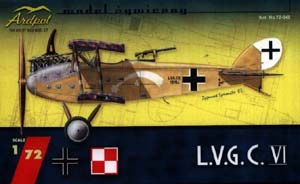Ardpol 1/72 resin LVG C.VI |  | History LVG C class airplanes were used by German aviation during WWI in great numbers, and the LVG C.VI is the ultimate and most perfect type in that line. Production of that type started in 1918 and till the end of the war about 1000 airframes were produced. Used mostly on the Western Front, it was a popular reconnaissance plane, fast, fairly agile, with good operational ceiling. After the war many were used in local conflicts, and also popular were "civilised" versions used as mail and passenger airplanes. The kit The "History" section was short, as I wanted to go to "The kit" as quickly as possible, because I'm so excited! This time Ardpol is better then ever, in my opinion they must have done some technological improvement. Kit parts have unbelievably immaculate surfaces, with extremely, I repeat, extremely fine details, much better that their earlier, very high quality kits. In my opinion they must be using some new silicone rubber to make moulds or new medium for masters, or maybe both. I wasn't able to find out what's going on - on my question about that producer answered: "I'm very happy that you liked that kit" - but probably he has some reasons to be enigmatic. OK - let's look closer into the colourful box: it contains resin parts packed into zip-bags of various size (wings are taped to the pieces of cardboard for greater safety), a small PE fret accompanied with acetate control panel details, a sheet of decals and detailed instructions showing the assembly process step-by-step. Decals and PE parts are excellent as usual Ardpol stuff, but the resin is better! Fuselage halves are thin, and details on the both inner and outer sides are amazing - sharp, tiny and delicate, panel lines, rivets on the engine covers, even tiny-tiny louvers on the inspection panels, three on each - just look at the closeup photo. Wings are similar, with flawless moulding even on the sharpest trailing edges. Smaller details are many, and excellent too. You can see all of them on the photos, note especially two variants of the exhaust and propeller. Level of detail is amazing also here, especially on the armament (which, by the way, looks like resin copy of the PE Eduard Spandau, but what a copy!) and other small details - again: look at the closeup photo. The only thing which could be better, are the tapes on the wing struts - in my opinion a bit too pronounced. Finally there are some photo-etched details: radiator, seatbelts, ammo drums, control panel and the radio - excellent. The decals Kit includes usual high quality Polish decals allowing the modeller to build two variant of that airplane, German wartime machine with lozenged wings (lozenge decals aren't provided) with interesting marking of the white "shooting star" on the fuselage sides, and Polish post-WWI machine with bright checkerboards over purple (or mauve?)/green camouflage. Conclusion In my opinion it is the best resin kit I've ever seen. As I wrote, some new technology must be involved. Yes, I've got the free kit for review, but my enthusiasm comes only from the real quality of that kit, you can believe me, I'm getting free review kits for about two years, from various top-quality producers. And no, I wasn't paid to review this kit especially well. There is only one "but" - this is still a resin kit, and a biplane with complex wing structure, so it can be tricky to build, even if the producer helped the modeller with the pins and holes in main parts, also for the struts. So - this is definitely the first-class product, but not for the beginner. Thanks to Ardpol for the review kit! |
|
